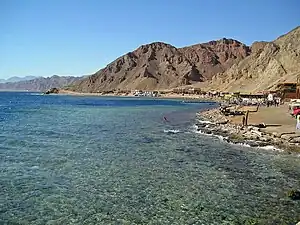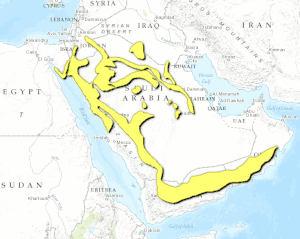| Red Sea Nubo-Sindian tropical desert and semi-desert | |
|---|---|
 | |
 Ecoregion territory (in yellow) | |
| Ecology | |
| Realm | Palearctic |
| Biome | Deserts and xeric shrublands |
| Geography | |
| Area | 652,683 km2 (252,002 sq mi) |
| Country | Saudi Arabia, Egypt, Israel, Jordan, Yemen |
| Coordinates | 24°15′N 39°15′E / 24.25°N 39.25°E |
The Red Sea Nubo–Sindian tropical desert and semi-desert ecoregion (WWF ID: PA1325) covers extremely arid land along the northeastern Red Sea, the southern Sinai Peninsula, and on a thin strip along the Israel-Jordan border. Most of the coastal land is flat, but there are high mountains in southern Sinai. Biodiversity is limited by the low moisture levels - some areas go for years without significant rain. Portions of the area support a thin savannah-like cover of widely scattered trees and scrub, surrounded by grasses that briefly flourish after a rainfall. Biodiversity is highest in the mountains of Sinai, and in the wadis and gullies that retain moisture.[1][2][3][4]
Location and description
"Nubo-Sindian" refers to the biogeographical region along the coast of the Arabian Peninsula.[5] The ecoregion stretches 2,000 kilometres (1,200 mi), from the Jordan River valley north of the Dead Sea, to just short of the Gulf of Aden in Yemen.[2] It also covers the southern slopes of the mountains in the south of the Sinai Peninsula, and reaches inland in low plains at various places along its length on the Arabian Peninsula. Small extensions to the east reach the Shammar Mountains in central Saudi Arabia. The terrain is sand and gravel on the flats, and granite and sandstone in the mountains.[4] The highest point is in the St. Catherine area of the southern Sinai, at 2,388 metres (7,835 ft).[3] The ecoregion bordering to the east is the Arabian Desert and East Sahero-Arabian xeric shrublands ecoregion.
Climate
The climate of the ecoregion is Hot desert climate (Köppen climate classification (BWh)). This climate features stable air and high pressure aloft, producing a hot, arid desert. Hot-month temperatures typically average 29–35 °C (84–95 °F).[6][7] Precipitation ranges from 50 mm/year to 100 mm/year.[4]
Flora and fauna
99% of the land area is bare ground, or sparse vegetation.[3] Shrubs and herbaceous vegetation are found in the deep wadis and gullies that can retain moisture, and after a rainfall there are areas that briefly sprout grasses.[4] Most of the plant diversity is in the southern Sinai, where 700 species of vascular plants have been recorded, and 35 endemic species.[4] A number of the endemic species of vertebrates are reptiles, including the endangered Sinai cat snake (Telescopus hoogstraali) and the endangered Phoenicolacerta kulzeri.[8]
Protected areas
Over 5% of the ecoregion is officially protected.[3] These protected areas include:
See also
References
- ↑ "Red Sea Nubo-Sindian tropical desert and semi-desert". World Wildlife Federation. Retrieved March 21, 2020.
- 1 2 "Map of Ecoregions 2017". Resolve, using WWF data. Retrieved September 14, 2019.
- 1 2 3 4 "Red Sea Nubo-Sindian tropical desert and semi-desert". Digital Observatory for Protected Areas. Retrieved August 1, 2020.
- 1 2 3 4 5 "Red Sea Nubo-Sindian tropical desert and semi-desert". The Encyclopedia of Earth. Retrieved August 28, 2020.
- ↑ Vegetation of the Arabian Peninsula (edited by S.A. Ghazanfar, M. Fisher). Retrieved October 20, 2020.
- ↑ Kottek, M., J. Grieser, C. Beck, B. Rudolf, and F. Rubel, 2006. "World Map of Koppen-Geiger Climate Classification Updated" (PDF). Gebrüder Borntraeger 2006. Retrieved September 14, 2019.
{{cite web}}: CS1 maint: multiple names: authors list (link) CS1 maint: numeric names: authors list (link) - ↑ "Dataset - Koppen climate classifications". World Bank. Retrieved September 14, 2019.
- ↑ "Wildfinder Database". World Wildlife Fund. Retrieved October 22, 2020.